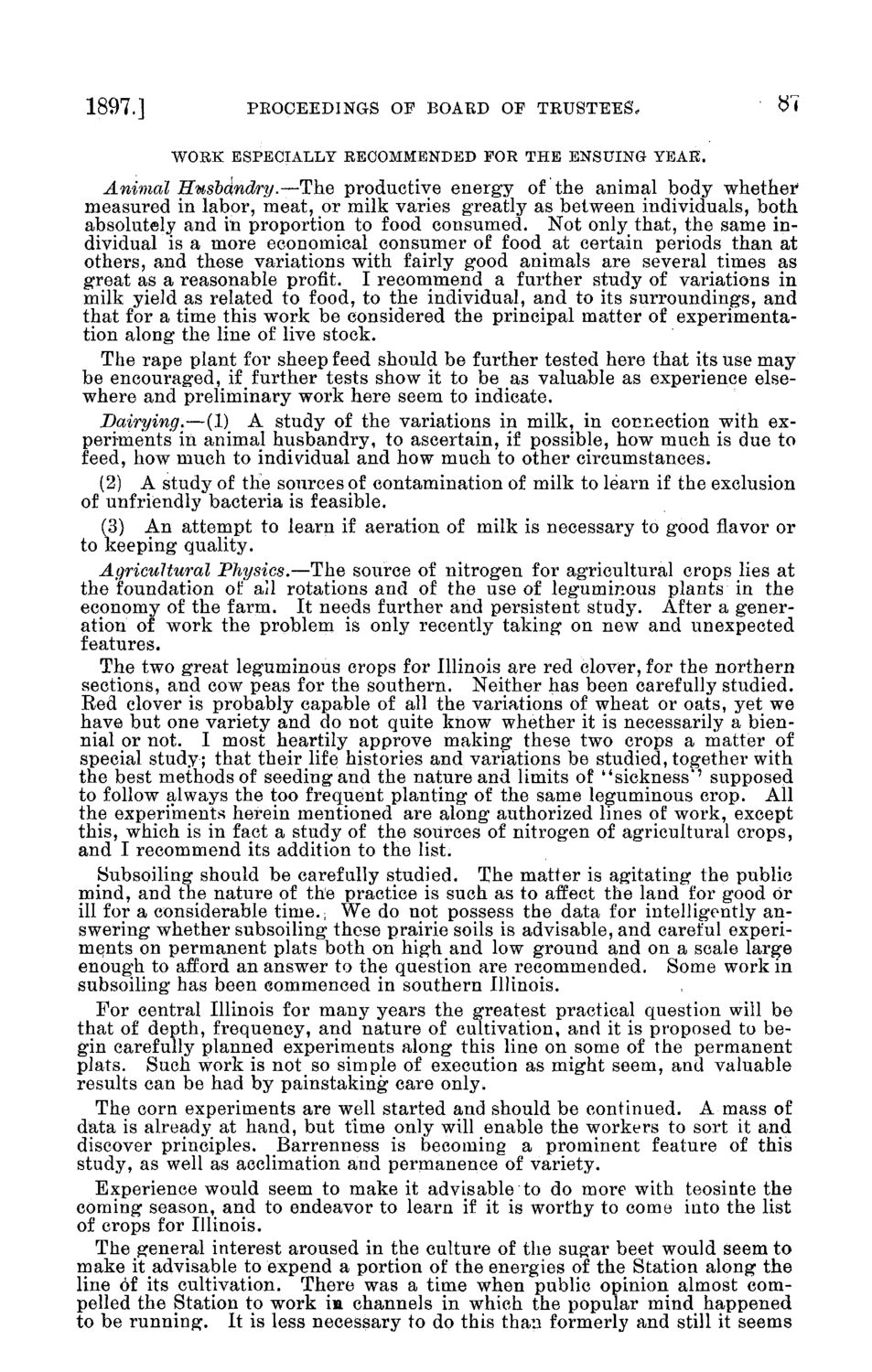| |
| |
Caption: Board of Trustees Minutes - 1898
This is a reduced-resolution page image for fast online browsing.

EXTRACTED TEXT FROM PAGE:
1897.] PEOGEEDINGS OE BOAED OF TRUSTEES, WORK ESPECIALLY RECOMMENDED FOR THE ENSUING YEAR. 87 Animal Husbandry .—The productive energy of the animal body whether measured in labor, meat, or milk varies greatly as between individuals, both absolutely and in proportion to food consumed. Not only that, the same individual is a more economical consumer of food at certain periods than at others, and these variations with fairly good animals are several times as great as a reasonable profit. I recommend a further study of variations in milk yield as related to food, to the individual, and to its surroundings, and that for a time this work be considered the principal matter of experimentation along the line of live stock. The rape plant for sheep feed should be further tested here that its use may be encouraged, if further tests show it to be as valuable as experience elsewhere and preliminary work here seem to indicate. Dairying.—(1) A study of the variations in milk, in connection with experiments in animal husbandry, to ascertain, if possible, how much is due to feed, how much to individual and how much to other circumstances. (2) A study of the sources of contamination of milk to learn if the exclusion of unfriendly bacteria is feasible. (3) An attempt to learn if aeration of milk is necessary to good flavor or to keeping quality. Agricultural Physics.—The source of nitrogen for agricultural crops lies at the foundation of: all rotations and of the use of leguminous plants in the economy of the farm. It needs further and persistent study. After a generation of work the problem is only recently taking on new and unexpected features. The two great leguminous crops for Illinois are red clover, for the northern sections, and cow peas for the southern. Neither has been carefully studied. Red clover is probably capable of all the variations of wheat or oats, yet we have but one variety and do not quite know whether it is necessarily a biennial or not. I most heartily approve making these two crops a matter of special study; that their life histories and variations be studied, together with the best methods of seeding and the nature and limits of "sickness"' supposed to follow always the too frequent planting of the same leguminous crop. All the experiments herein mentioned are along authorized lines of work, except this, which is in fact a study of the sources of nitrogen of agricultural crops, and I recommend its addition to the list. Subsoiling should be carefully studied. The matter is agitating the public mind, and the nature of the practice is such as to affect the land for good or ill for a considerable time.; We do not possess the data for intelligently answering whether subsoiling these prairie soils is advisable, and careful experiments on permanent plats both on high and low ground and on a scale large enough to afford an answer to the question are recommended. Some work in subsoiling has been commenced in southern Illinois. For central Illinois for many years the greatest practical question will be that of depth, frequency, and nature of cultivation, and it is proposed to begin carefully planned experiments along this line on some of the permanent plats. Such work is not so simple of execution as might seem, and valuable results can be had by painstaking care only. The corn experiments are well started and should be continued. A mass of data is already at hand, but time only will enable the workers to sort it and discover principles. Barrenness is becoming a prominent feature of this study, as well as acclimation and permanence of variety. Experience would seem to make it advisable to do more with teosinte the coming season, and to endeavor to learn if it is worthy to come iuto the list of crops for Illinois. The general interest aroused in the culture of the sugar beet would seem to make it advisable to expend a portion of the energies of the Station along the line of its cultivation. There was a time when public opinion almost compelled the Station to work m channels in which the popular mind happened to be running. It is less necessary to do this than formerly and still it seems
| |